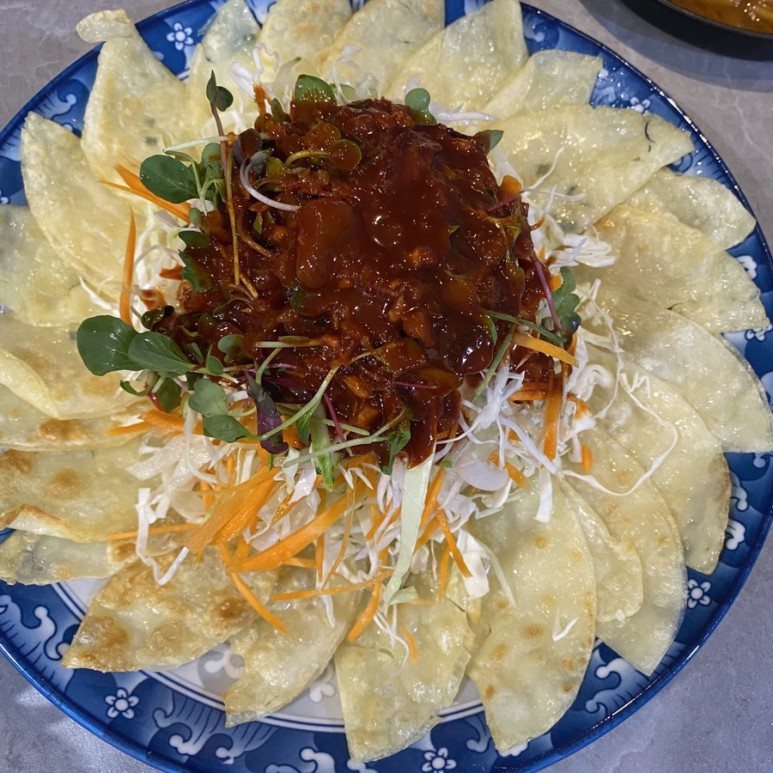Nostalgic Taste! Bibim Mandu with Daegu-Style Flat Dumplings
The Charm of Daegu’s Flat Dumplings! Easy Bibim Mandu Recipe

One day, I felt inspired to cook and decided to make delicious bibim mandu using Daegu’s famous flat dumplings! While making them from scratch can be a bit daunting, using store-bought flat dumplings makes it incredibly convenient. You can easily find affordable and tasty ones by searching ‘flat dumplings’ on Naver. Because of the nostalgic memories of eating flat dumplings in my childhood in the Gyeongsang Province, I ordered a generous pack of 200! When I pan-fried the freshly made flat dumplings and mixed them with a sweet and tangy seasoned vegetable salad, the taste was simply fantastic. Flat dumplings have a subtly captivating charm despite their simple flour taste! When tossed with fresh vegetables, what could be a better late-night snack? They also pair wonderfully with jjolmyeon (chewy noodles), golbaengi muchim (spicy whelk salad), or even tteokbokki (spicy rice cakes). Shall we make some refreshing bibim flat dumplings that will awaken your appetite this morning? This visually appealing dish, offering a generous portion at an affordable price, is truly amazing! This taste from the past has uplifted my mood considerably!
Main Ingredients- 25 Flat Dumplings (Napak Mandu)
- Generous amount of cooking oil
Vegetable Ingredients- 1/8 head of Cabbage
- 1 Onion
- 1/2 Carrot
- 1 Cucumber
- Use up any leftover vegetables in the fridge (e.g., perilla leaves)
Bibim Mandu Seasoning- 2 Tbsp Gochujang (Korean chili paste)
- 2 Tbsp Omija Cheong (Schisandra berry syrup)
- 2 Tbsp Vinegar
- 1 Tbsp Minced Garlic
- Pinch of Sesame Seeds
- 1/8 head of Cabbage
- 1 Onion
- 1/2 Carrot
- 1 Cucumber
- Use up any leftover vegetables in the fridge (e.g., perilla leaves)
Bibim Mandu Seasoning- 2 Tbsp Gochujang (Korean chili paste)
- 2 Tbsp Omija Cheong (Schisandra berry syrup)
- 2 Tbsp Vinegar
- 1 Tbsp Minced Garlic
- Pinch of Sesame Seeds
Cooking Instructions
Step 1
First, prepare the vegetables you have in your refrigerator. I’ve chosen cabbage, onion, cucumber, and carrot, but feel free to add perilla leaves or any other vegetables you like! Wash all vegetables thoroughly and then julienne them as thinly as possible. The thinner the julienne, the better the seasoning will coat and the softer the texture will be.

Step 2
Now, let’s make the vegetables extra crisp! Place the julienned vegetables in a large bowl or basin, and fill it with ice water. Let them soak for at least 30 minutes. This process revitalizes the vegetables and brings out a wonderfully crisp texture. You can expect a crunchiness that’s as if they were just picked! It’s truly remarkable how this simple step transforms the vegetables.

Step 3
Once the vegetables have become crisp after soaking in ice water, drain them thoroughly using a colander. Ensuring they are well-drained prevents the seasoning from becoming watery and helps preserve the vegetables’ natural flavors. Seeing these crisp vegetables ready makes your mouth water, doesn’t it? If you have perilla leaves, julienning and adding them will enhance the aroma and flavor even further. By the way, if you boil some jjolmyeon noodles and add them, this dish transforms into a delicious jjolmyeon bibim!

Step 4
Now it’s time to cook the flat dumplings. Heat a generous amount of cooking oil in a frying pan. Be careful with frozen flat dumplings as they tend to stick and tear if you try to separate them immediately after taking them out! A good tip for cooking flat dumplings is to place them in the pan as a clump initially. As they start to cook, gently separate them layer by layer. This method helps them cook evenly without tearing. Since they are thin and can burn quickly, pay attention to the heat control. (You might shed a tear or two when cooking these thin dumplings!)

Step 5
Once the dumplings are golden brown and crispy, arrange them beautifully on a plate. Cooked flat dumplings resemble a blooming flower with their attractive appearance. If you prefer a crispier texture, cook them for a longer duration until thoroughly crisp. If you prefer a softer texture, cook them only lightly. You can adjust the cooking time according to your preference.

Step 6
On top of the crispy fried flat dumplings, generously pile the julienned vegetables you prepared earlier. Wrapping the vegetables with the dumplings and eating them together is incredibly delicious! If you add boiled jjolmyeon noodles, you’ll have a hearty jjol-bibim mandu. It also pairs wonderfully with simple boiled bibim-myeon noodles, and enjoying it alongside spicy tteokbokki is another delightful option.

Step 7
Use up all the vegetables you have in your fridge!

Step 8
Now, let’s make the delicious bibim mandu seasoning! While the conventional method involves mixing gochujang, gochugaru, vinegar, sugar, and garlic, I’m using a method taught by my mother that utilizes Omija Cheong (Schisandra berry syrup). Omija Cheong itself is rich in sweet and sour flavors, so you can create a delicious seasoning without adding extra sugar or vinegar. It’s incredibly simple! Just mix 1 tablespoon of minced garlic with equal parts gochujang and omija cheong, and it’s done. If you prefer a tangier taste, add a little more vinegar.

Step 9
Drizzle a generous amount of the seasoning over the vegetables, and your delicious bibim flat dumplings are complete! If you have gochujang-based dipping sauce (cho-gochujang) at home, you can use that for a quick and tasty option. Enjoy your meal!




